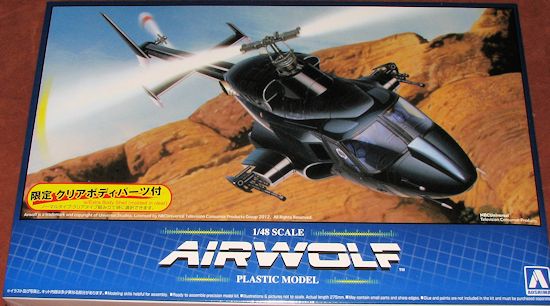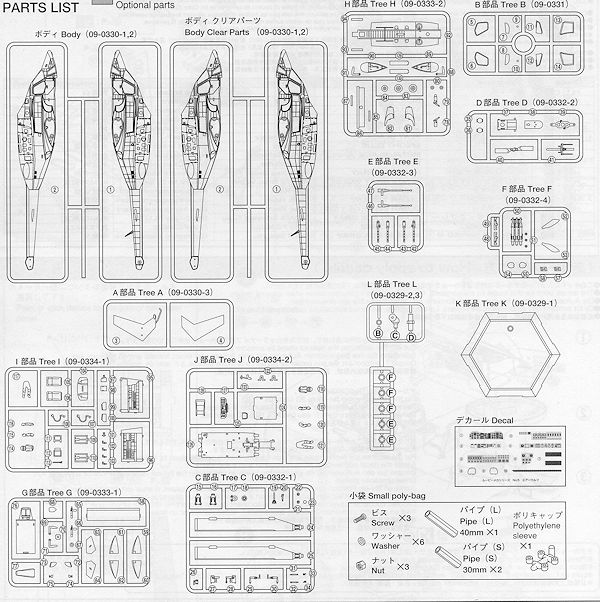
Aoshima 1/48 Airwolf
| KIT #: | 005590 |
| PRICE: | $68.00 SRP |
| DECALS: | One option |
| REVIEWER: | Scott Van Aken |
| NOTES: |

| HISTORY |
The flying Airwolf was derived from an example of Bell 222, a twin-turboshaft helicopter produced for the civilian market and typically employed for corporate, emergency medical or utility transport missions, with seating for up to 10, including the pilot.
The airframe used for Airwolf was serial number 47085 (registration number N3176S), of the initial production version, sometimes unofficially called a Bell 222A. During filming of the series the helicopter was owned by JetCopters Inc. in Van Nuys, California.
After the show was canceled the modifications were removed (now owned by a private collector) from the actual helicopter. It was repainted and eventually sold to the German helicopter charter company, Hubschrauber-Sonder-Dienst (aka HSD Luftrettung and Blue Helicopter Alliance), and given the registration number D-HHSD. While operating as an air ambulance the helicopter crashed in fog on June 6, 1992, killing all three of its occupants.
A new, full-size replica of the Airwolf helicopter was created for display in the short-lived Helicopter Headquarters museum in Pigeon Forge, Tennessee that opened in August 2006, using a non-flying Bell 222 with molds taken directly from the originals used in the show. The museum was unsuccessful, and offered the replica for sale through eBay. The replica is now housed in the Tennessee Museum of Aviation, Sevierville, Tennessee.
Airwolf was painted Phantom Gray Metallic (DuPont Imron 5031X) on top, and a custom pearl-gray (almost white) on the bottom, in a countershaded pattern. The craft was also fitted with various prop modifications, such as "turbo jet" engines and intakes, an in-air refueling nozzle and blister cowling on the nose, retractable chain guns at the wingtips, and a retractable rocket launcher, known as the "ADF Pod" (ADF standing for All Directional Firing, as the pod could rotate 180 degrees to fire at targets at the sides - 90 degrees to the left, forward, or 90 degrees to the right) on its belly.
The look of the modifications was designed by Andrew Probert, and they were first applied to the non-flying mock-up (built from the body of the very first Bell 222, serial number 47001). From this mock-up molds were made so that parts could be made to FAA specifications before they were added to the flying helicopter. After the maiden flight with the modifications, primary pilot David Jones told the producer that "It flies better now than before!"
After the first season, the producers were advised that "chain gun" is a registered trademark of McDonnell Douglas, and they were not referred to as such again. The machine guns mounted on the side of the landing gear sponsons were mock-ups that used spark plugs and fuel to simulate gun firing. Other modifications were implied with Foley and sets; the interior sets were of a fantastical high-tech nature, and there were implied "stealth" noise-reducing capabilities with creative use of sound effects. On the show, the deployment of the weapons systems were usually shown via close-ups of the action; in reality, these close-ups were produced on props off-site, while the non-moving prop components were attached to the aircraft by a technician in the field or at the JetCopters hangar.
The concept behind Airwolf was a super fast and armed helicopter that could "blend in" by appearing to be civilian and non-military in origin, a "wolf in sheep's clothing". Airwolf's insignia patch (also designed by Probert) as worn by the flight-crew was a snarling wolf's head with gossamer wings that appears to be wearing a sheepskin complete with the head of lamb over the wolf's forehead. Airwolf is sometimes referred to in-show as "The Lady" by Santini and Hawke.
In the show, Airwolf was an armored, stealthy aircraft. It could perform impossible maneuvers and stunts, including traveling at mach speeds (the theoretical maximum speed of a helicopter is significantly below Mach 0.5, or half the speed of sound), flying upside down, and flying into the stratosphere. Some of these impossible capabilities are explained in the show by such features as auxiliary jet engines (visible at the roots of the landing gear sponsons), rotor blades that can be disengaged for supersonic flight and a lifting body fuselage.
Sound effects were also associated with many of the aircraft's abilities. When Airwolf bolted across the sky in "turbo boost" mode, one would hear it "howl like a wolf" as it made a glass-shattering sound effect. When sitting idle, the aircraft made a mechanical trilling sound, and while hovering the rotor blades made a ghostly wind drone.
The weapons were state-of-the-art, with machine guns that could rip apart tanks and bunkers. The belly missile pod could fire a variety of rockets, including air-to-surface Mavericks, Hellfires, and heat-seeking air-to-air Sidewinders. When fired, these rockets usually glowed like a laser bolt or "photon torpedo" from Star Trek. Airwolf was also equipped with an advanced computer system which could identify and track aircraft and ground vehicles. It could display 3D wireframe models and schematics of its targets. The communications system could eavesdrop on radio and telephone conversations, tap into and foul up computer systems, jam enemy transmission frequencies and disrupt ground-based electrical systems. The stealth systems were capable of rendering Airwolf invisible to radar, as well as producing multiple radar returns. The weapons system could be tied in with the communications system to lock the missiles onto any monitored electronic system. In the first episode, a Bullpup missile was launched from Airwolf against an American destroyer while the helicopter was being used by its in-story inventor, Doctor Charles Henry Moffet.
In one episode ("Airwolf II"), Airwolf had a twin, Airwolf II, also known as Redwolf. Redwolf was secretly built by The FIRM to replace Airwolf, but was subsequently stolen and flown by Harlan Jenkins, its egotistical creator and test-pilot rival of Stringfellow Hawke. Redwolf differed from Airwolf in that its underbelly was painted red (where Airwolf was painted pearl-grey). It was also equipped with a powerful laser weapon coupled with a quick-firing, single-tube rocket pod (although in reality it had no external modifications to the Bell 222 like Airwolf). Season 4 also featured a similar copter to Redwolf, known as the Scorpion, though the footage of the dogfighting was recycled from the "Airwolf II" episode.
| THE KIT |
 From a
snippet of information in Wiki, it seems that this kit was first issued in 2009.
It has apparently gone through several boxings, this one being highlighted by
having clear plastic fuselage halves included with the regular kit. Just what
the advantage is to the clear plastic I am not sure, but it is there for those
who want to leave sections of the airframe clear to see interior detail.
From a
snippet of information in Wiki, it seems that this kit was first issued in 2009.
It has apparently gone through several boxings, this one being highlighted by
having clear plastic fuselage halves included with the regular kit. Just what
the advantage is to the clear plastic I am not sure, but it is there for those
who want to leave sections of the airframe clear to see interior detail.
This builds a bonafide Airwolf helo and not just a gussied up Bell 222. The fuselage halves have the jet engine intake and exhaust molded into them so you could not do a 222 without some major fuselage modification.
The cockpit is very nicely detailed with rudder pedals, both cyclic and collective controls and very nicely done seats. Raised detail is offered for both the instrument panel and the weapons operator panels, though decals are also provided for these if you wish. The back seater's position even includes a laptop computer! Seats are superbly molded and you get a pair of crew figures should you wish to use them.
Apparently the sponson mounted guns are able to be rotated just as in the one for the TV show as thier construction is rather complex. Conversely, it appears you can mold them closed, which is far less cool. You get a very nicely done rotor head and blade assembly as well. The nose mounted sensor fairing is included and so are a set of triple missile launchers for the centerline. The kit can be built gear up if you wish and perhaps this would be a good option as there is not a lot of room in the nose for weight. A rather complex looking articulated display stand is provided and is held together by nuts and bolts as apparently it is made of a material that cannot be glued with standard cements.
Instructions are well done though mostly in Japanese. The instructions provide mixing instructions for the upper grey and the underside white, however, there are rattle can paints from Tamiya that will probably be more suited to this as they do a nice pearlescent white and a very dark metallic grey that will work well for the model. Contrary to popular belief, the name Airwolf was not applied to the helo and the small decal sheet (not shown) does not include this either. In fact, the aircraft was rather non-descript in terms of extraneous markings.
| CONCLUSIONS |
Previous, we have only had the now-crude AMT/ERTL kit, which has still garnered some pretty hefty prices for collectors. This one is superior in all respects and for those wanting to build an Airwolf, this is the kit I would recommend.
| REFERENCES |
http://en.wikipedia.org/wiki/Airwolf_%28helicopter%29
March 2013 Thanks to www.dragonmodelsusa.com
for the preview kit. You can find this kit at your favorite hobby shop
or on-line retailer. If you would like your product reviewed fairly and fairly quickly, please
contact
the editor or see other details in the
Note to
Contributors.